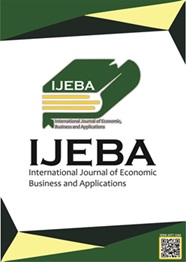Author Guidelines
- The guideline is available in PDF document and (PDF download)
- Download Article Template
The editor of IJEBA received a scientific manuscript from the community service activities written in Bahasa Indonesia or English. The manuscript is the author's original scientific work and is not the result of plagiarism.
The manuscript is typed with Microsoft Office Word® according to the journal template provided. The manuscript contains minimum 3000 words (not including bibliography) and is typed in documents with A4 paper size. The author is required to use article template provided by the editor on the journal website.
(1) Title: The title of the manuscript is written short and no more than 150 letters in the Bahasa Indonesia and/or English versions. The title is written informative and illustrates the main content of the writing. The editor suggested that the authors compose titles that can attract reading interest.
(2) Author Name: Write the author names without a title followed by his/her affiliation. Affiliation is the origin of the faculty and university for those who come from academic institutions. The affiliation can be the name of the institution for writers from non-academic institutions. All authors who contributed to the article included their email address. The editor suggested the author also include scholar profile links such as ORCID and Scopus (if any). The more complete the author's information submitted on the article will make it easier for the writer to connect to the manuscript online.
(3) Abstract: Write the abstracts in two versions, Bahasa Indonesia and English, each with a maximum of 180 words. The abstract contains briefly the main contents of the writing, including objectives, problems or questions, method, and the results obtained from the community services.
(4) Keywords: The keyword is an essential part of abstracts. The author sets 5-8 specific keywords and reflects what is important about the article. The author is required to align the Title, Abstract, and Keywords in the manuscript.
(5) Contents: The contents of the manuscript contain the parts of the Introduction, Method of Application, Results and Achievement of the Goals, Conclusions, Acknowledgments, and References. Make sure the contents of the manuscript, except for the Acknowledgements section, DO NOT CONTAIN THE PERSONAL IDENTITIES OR AFFILIATIONS OF THE AUTHOR(s).
Introduction
The introduction part contains background, problem formulation, activity objectives, and literature review. The author is required to express quantitatively the portrait, profile, and condition of the target audience involved in community service activities. It can also be described as the conditions and potential of the region in terms of physical, social, economic, and environmentally relevant to the activities carried out. Also, explain the potential used as material for community service activities. The author is asked to formulate the problem concretely and clearly in this section. Explain the objectives to be achieved in community service activities. This section is supported by a literature review which serves as a support to the concept of community service. Authors are required to present primary literature studies (references to journal articles and conference proceedings) and up-to-date (references published within the last five years). The literature review is not limited to theory but also empirical evidence. Enrich this introduction with the efforts that have been made by other parties. This article is the result of community service, which is downstream of the research results, it can be in the form of the results of the research itself or other researchers.
Method of Application
In the application method section, describe clearly and concisely the method used to achieve the goals that have been set forth in the service activities. The results of that dedication must be measurable and the author is asked to explain the measurement tools used, both descriptively and qualitatively. Explain how to measure the level of success of service activities. The level of achievement can be seen in terms of attitudes, socio-cultural, and economic changes in the target community.
Results and Achievement of the Goals
Community service is an effort to disseminate science, technology, and art to the community. These activities must be able to provide an added value to the community, both in economic activities, policies, and behaviour changes (social). This part describes what the community service activity has been able to provide change for individuals/communities and institutions, both short and long term. In this section, describe how operations are carried out to achieve the objectives. Explain the indicators of objectives achievement and the benchmarks used to state the success of the activities that have been carried out. Express the strengths and weaknesses of the outcome or the main focus of the action in accordance as it seen on the conditions of the community. Explain also the level of difficulty of the implementation, the production of goods, and the opportunities for future development. The author can reinforce the article with relevant documentation related to services or goods as outputs, or the main focus of the activity. Documentation can be in the form of pictures of the process of implementation, the figure of a prototype product, tables, graphs, and so on.
Conclusion
Summarise the results of community service both in the form of successes and obstacles found in the activity. The obstacles listed in this section provide an opportunity for writers to submit suggestions for sustainability and improvement in the future.
Acknowledgements (if necessary)
This section must be written if the institution funds the community service that produces this paper. In this section, the author expresses his/her gratitude to the funding agency. And if necessary, the author can also state other institutions that contribute to the implementation of activities. The author can write down the contract number or document number of the cooperation agreement with partners.
(6) Table and Figure: Tables and figures are part of the manuscript and are not separated from the body of the paper. Put tables and figures in a place that fits the narration so that they complete the description. Number the tables and figures according to the order in which they appear on the text. Give the title of each table and figure. The images included in the manuscript must be of good quality. The figure does not stand alone and must be part of the paper. Please note that the figure is not documentation that is not related to the discussion of the manuscript. Make sure the manuscript does not display pictures that show the identity or information related to the authors.
The printed version is printed in black and white, and the author should adjust the picture according to the conditions. Examples of laying and naming pictures can be seen here.
(7) References: For good quality articles, editors require authors to use primary references (journals) with a composition of at least 80% compared to other references in the bibliography. Authors are asked to use the most recent works published in the last ten years. This journal does not use footnotes in the body of the manuscript, all sources of literature follow the rules of writing citation and bibliography.
Starting in 2020, the citation format in the manuscript and bibliography display at the IJEBA follows the American Physicological Association (APA). More complete, the author can learn the writing in the APA Format Citation Guide or can follow the instructions below.
All citations in the text must be included in the references, and all references must be mentioned in the text. Check the reference list against literature citations in the text before submitting the manuscript for publication. Ensure that working papers and in-press articles have not been published before submitting your work. For proper reference management, the editor recommends that the writer use a reference management application such as Mendeley, EndNote, Zotero, or Microsoft Office Word Citations & Bibliography.
Guidelines for Manuscript Submissions
Manuscripts for publication are written in Indonesian or English and following the writing guidelines. Editors will not accept documents that do not comply with this provision.
IJEBA has used the management of scientific manuscript publishing based on the Open Journal System (OJS). Manuscripts received by editors in latest Microsoft Office Word® format (*.docx). Author needs to register with the journal prior to submitting or, if already registered, can simply log in and begin the five-step process. The author can also watch the tutorial video How to submit the manuscript in OJS 3.0.
Manuscripts that have passed selection from the editorial board will then go through a peer-review process. The authors are allowed to revise their article if there are suggestions for improvement from reviewers. The manuscript will be published in the journal after it is declared eligible to be published by the editorial board.
For further information related to the technical submission of the manuscript, you can contact the editor via email ijeba@ejournal.unri.ac.id.
Copyright Notice
Author(s) retain the copyright of articles published in this journal, with first publication rights granted to Riau Journal of Empowerment. All journal content is licenced under Creative Commons Attribution 4.0 International License. This license permits unrestricted use, distribution, and reproduction in any medium, provided the original author and source are credited.
Privacy Statement
The names and email addresses entered in this journal site will be used exclusively for the stated purposes of this journal and will not be made available for any other purpose or to any other party.





.png)
.png)
.png)


